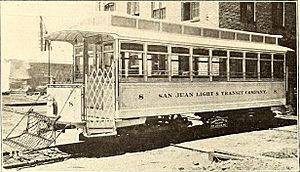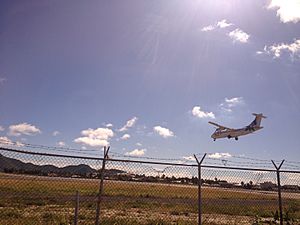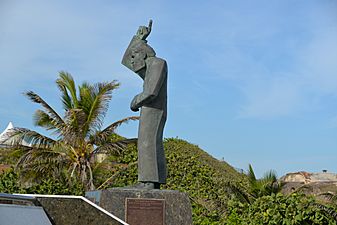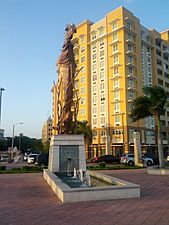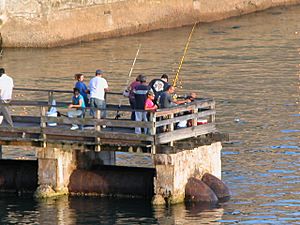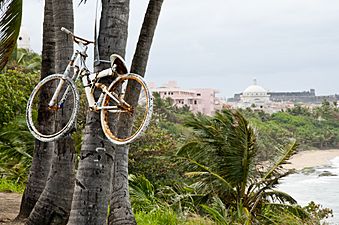Puerta de Tierra, San Juan facts for kids
Quick facts for kids
Puerta de Tierra
|
|
|---|---|
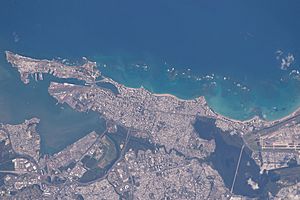
Satellite image of San Juan Antiguo and Puerta de Tierra
|
|

Puerta de Tierra is in San Juan Antiguo
|
|
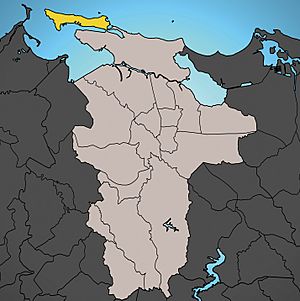
San Juan Antiguo is in San Juan
|
|
| Commonwealth | |
| Municipality | |
| Time zone | UTC−4 (AST) |
Puerta de Tierra is a special area, or subbarrio, located on the eastern side of the Isleta de San Juan in San Juan, Puerto Rico. Its name, which means "land gate" in Spanish, comes from an old gate that used to be the main entrance to the walled city of San Juan. Today, Plaza Colón stands where this gate once was.
As of 2010, Puerta de Tierra was the most populated part of San Juan Antiguo, with 2,924 people living there. This historic area was added to the National Register of Historic Places on October 15, 2019. This means it's now recognized as an important place in history, just like the Old San Juan Historic District.
Contents
History of Puerta de Tierra
Early Inhabitants
Before Europeans arrived, the area of Puerta de Tierra and Old San Juan was a smaller island. It was home to the Taíno people. Scientists have found signs of a small Taíno fishing village where the Puerto Rico National Guard Museum is now. Sadly, many other ancient sites were lost when new roads and buildings were constructed.
Spanish Settlement
The Spanish began settling Puerto Rico in 1508. Juan Ponce de León founded the first town, Caparra, near the San Juan Bay. In 1519, they moved across the bay and started a new settlement called Puerto Rico de San Juan Bautista, which is now Old San Juan.
The area of Puerta de Tierra became very important for defending the Islet of San Juan. It was the closest point to the main island of Puerto Rico. A narrow channel, called the San Antonio strait, separated it from the main island. The first bridge over this channel was built by enslaved Taínos between 1520 and 1521.
In 1594, a group of people of African descent were accused of practicing non-Christian rituals in Puerta de Tierra. They were forced to change their beliefs. Some who refused were severely punished.
San Juan's Growth Eastward
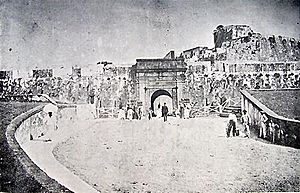
Building the strong walls around San Juan started in 1634. For a long time, the area outside the city walls, to the east of Old San Juan, was mostly empty. But in the 1800s, it became the first part of San Juan to expand beyond its walls. Some of the first people to settle here were freed families from British, Dutch, and Danish islands in the Caribbean.
Most homes were simple wooden huts. These homes were often built near the eastern walls and the Puerta de Santiago (Santiago Gate). Because this gate was the main way to enter the walled city by land, it became known as Puerta de Tierra, or "Land Gate."
The area grew even more after the Fort San Cristóbal was expanded in 1771. A new main road, the Camino Real (now Ponce de León Avenue), was built in 1810. In 1797, the British attacked San Juan during a war. The local Spanish soldiers and Afro-Puerto Rican fighters successfully defended the city. This led to more defenses being built in Puerta de Tierra. You can still see parts of these old military sites in Luis Muñoz Rivera Park today. By 1838, Puerta de Tierra had 168 residents, many of whom were of African descent.
Changes After 1867
In 1865, San Juan's military defenses were updated. But the eastern part of the city walls was no longer needed and was partly taken down. A big earthquake in 1867 destroyed the remaining military buildings in the area. After this, a new road and a railway station were built. The San Juan streetcar system started running along the Camino Real in 1880.
At this time, the southern coast of Puerta de Tierra began to develop with piers and docks along the San Antonio Channel. Puerta de Tierra became the most populated part of the Islet of San Juan. A new church, schools, and streets were built. Even though the area grew quickly, many homes were built without a plan.
Spanish–American War and Beyond
The United States took control of Puerto Rico from Spain after the Spanish–American War in 1898. In 1899, the first census by the United States showed that 5,453 people lived in Puerta de Tierra. A powerful storm, the San Ciriaco hurricane, also hit the area hard in 1899.
The 20th Century
Puerta de Tierra saw many changes in the early 1900s. Barriada Miranda became the first planned public housing area in 1903. In 1907, politician Luis Muñoz Rivera suggested building the territorial capitol where the old city walls used to be. The first public elementary school, José Julián Acosta School, also opened here in 1907.
The main road through Puerta de Tierra was known as the "Broadway of Puerto Rico." This was because many theaters and cultural places were built there. The Tres Banderas Theater, for example, was the first movie theater in the area in 1910. Some of the first non-Catholic churches in San Juan were also built here in the 1910s.
The 1928 Okeechobee hurricane caused about 300 deaths in Puerta de Tierra. This and other problems like disease outbreaks slowed down the area's growth. However, World War II brought more industrial activity to the area. Puerta de Tierra also saw the first use of condominiums as public housing in the United States. Soon, multi-story buildings replaced many single-family wooden houses.
Cityscape and Location
| Historical population | ||
|---|---|---|
| Year | Pop. | ±% |
| 1899 | 5,453 | — |
| 1910 | 10,836 | +98.7% |
| 1920 | 15,716 | +45.0% |
| 1930 | 11,936 | −24.1% |
| 1935 | 13,356 | +11.9% |
| 1940 | 11,480 | −14.0% |
| 1950 | 9,114 | −20.6% |
| 1960 | 8,075 | −11.4% |
| 1970 | 6,143 | −23.9% |
| 1980 | 5,522 | −10.1% |
| 1990 | 5,366 | −2.8% |
| 2000 | 4,135 | −22.9% |
| 2010 | 2,924 | −29.3% |
| Populations of military and naval reserves are not included from 1899 through 1940. | ||
Puerta de Tierra is on the eastern part of the Isleta de San Juan. It connects to the main island by bridges like Dos Hermanos and San Antonio, and a causeway. The Atlantic Ocean is to its north. To the east are El Boquerón and El Condado. The San Antonio Channel is to the south, and Old San Juan is right to the west.
Many of Puerto Rico's government buildings are in Puerta de Tierra, including the Capitol of Puerto Rico. In 2000, Puerta de Tierra had 4,135 people and covered about 0.60 square miles (1.55 km²). This makes it the largest and most populated subbarrio in San Juan Antiguo.
In October 2017, Puerta de Tierra received an award from the International Union of Architects. This group, based in Switzerland, recognized Puerta de Tierra for having the "best public spaces."

National Historic Recognition
On October 15, 2019, Puerta de Tierra was officially added to the National Register of Historic Places. This was a big moment for the community. Bibiana Hernández had worked for many years to get this recognition. She was very happy with the news. Many people, including artist Jesús “Bubu” Negrón and architect Arleen Pabón-Charneco, also helped bring attention to the area.
This special recognition means that the entire Isleta de San Juan is now a historic district. This includes the Old San Juan Historic District. This status should help get federal money to protect and care for the area. Before this, thirteen buildings in Puerta de Tierra were already on the National Register. These include El Falansterio, Brambaugh School, and the José Celso Barbosa Graded School.
You might see murals in Puerta de Tierra that say Aquí vive gente, which means "People live here." The community is also planning to create a museum about Puerta de Tierra's history.
Fun Places to Visit
Hotels and Beaches
- Caribe Hilton Hotel
- Normandie Hotel
- Escambrón Beach Club
- Escambrón Beach
Parks and Recreation Sites
- Luis Muñoz Rivera Park
- Third Millennium Park
- Sixto Escobar Stadium
Famous People from Puerta de Tierra
- Antonia Pantoja - a well-known educator, social worker, and civil rights leader. She founded several important organizations like ASPIRA and Boricua College. She was the first Puerto Rican woman to receive the American Presidential Medal of Freedom.
Gallery
Sites in and around Puerta de Tierra:
See also
 In Spanish: Puerta de Tierra (San Juan Antiguo) para niños
In Spanish: Puerta de Tierra (San Juan Antiguo) para niños



